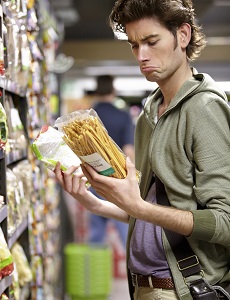Food Safety
How do you know if food is safe to eat? Sometimes it's obvious - moldy or rotten food has gone bad. Other times it's hard to tell. The more time your food spends in the temperature "danger zone" (40 - 120 degrees F), the more likely it will be unsafe to eat. If you leave food out on the counter or in a hot car, it could be unsafe even before the date on the package. Keeping food properly stored and using it before it becomes unsafe will go a long way to reducing wasted food.
Dates stamped on food packages are helpful, but what do these dates really mean? Savethefood.com has useful information about food safety and product dating. Here are the basics:
- "Sell by" dates tell the store how long to display a product for sale. Food past this date is generally still safe to eat.
- "Best before" dates are about food quality. After these dates foods are safe to eat, but they are past their peak flavor or quality.
- "Use by" dates are the last dates that foods are at peak quality. These dates are set by the manufacturer and are usually about quality, not safety. After this date, food should be safe if it has been stored properly.
- Cans: Dates stamped on cans do not have to do with food safety. As long as the can is not damaged and has not been frozen or above 90 degrees F, the canned food should be safe to eat.
- Eggs: Even if the date stamped on eggs has passed, eat them within three to five weeks of purchasing. If they are properly stored in the refrigerator, they are safe to eat.
Remember, proper storage is key! We can't say for sure how long after "use by" dates food will be good, but if you store the food properly it should last longer.
Donate Your Extra Food
"There is nothing new about poverty. What is new, however, is that we now have the resources to get rid of it."
Martin Luther King Jr.
Today nearly 50 million Americans have inconsistent or unreliable access to food. This means that roughly one out of six adults and one out of five children are food insecure. Reducing food loss in the U.S. by just 15% could help feed more than 25 million Americans.
One step you can take towards reducing wasted food in your home is to donate food you no longer want or think you won't eat. It is easiest to donate commercially packaged goods that do not need refrigeration.
Mobile Apps and Web Tools
There are numerous free and low-cost mobile apps and web tools that can help you make the most of your groceries. Try these free apps and see how much of a difference they can have in your daily life.
 |
Cozi
Features: shopping list, meal planner, recipes, storage
Compatible with: Android, BlackBerry, iPhone, iPod touch, and iPad |
 |
Love Food Hate Waste
Features: portion planner, recipe "blender", hints and tips, meal planner, shopping list
Compatible with: Android, iPhone, iPod touch, and iPad |
 |
Grocery iQ
Features: food database, coupons, barcode scanning, grocery list
Compatible with: Android, iPhone, iPod touch, and iPad |
 |
Food on the Table
Features: sales/discounts by store location, recipes, meal planner, shopping list
Compatible with: Android, iPhone, iPod touch, and iPad |
 |
222 Million Tons
Features: meal planner, shopping list
Compatible with: iPad |
What You Can't Use, Compost!
Reducing the amount of food you waste is important, but so is what you do with your scraps and spoiled food. Consider compost. Keeping a compost bin or pile is easy. You can also put uneaten food in your City of Tacoma food/yard waste bin for composting at a local facility. Composting is a great way to put food waste to use, improve soil quality, and reduce the amount of waste that goes to the landfill. To see a helpful infographic about composting,visit the website of the Institute for Local Self-Reliance, a national nonprofit organization working to strengthen local economies, and redirect waste into local recycling, composting, and reuse industries.